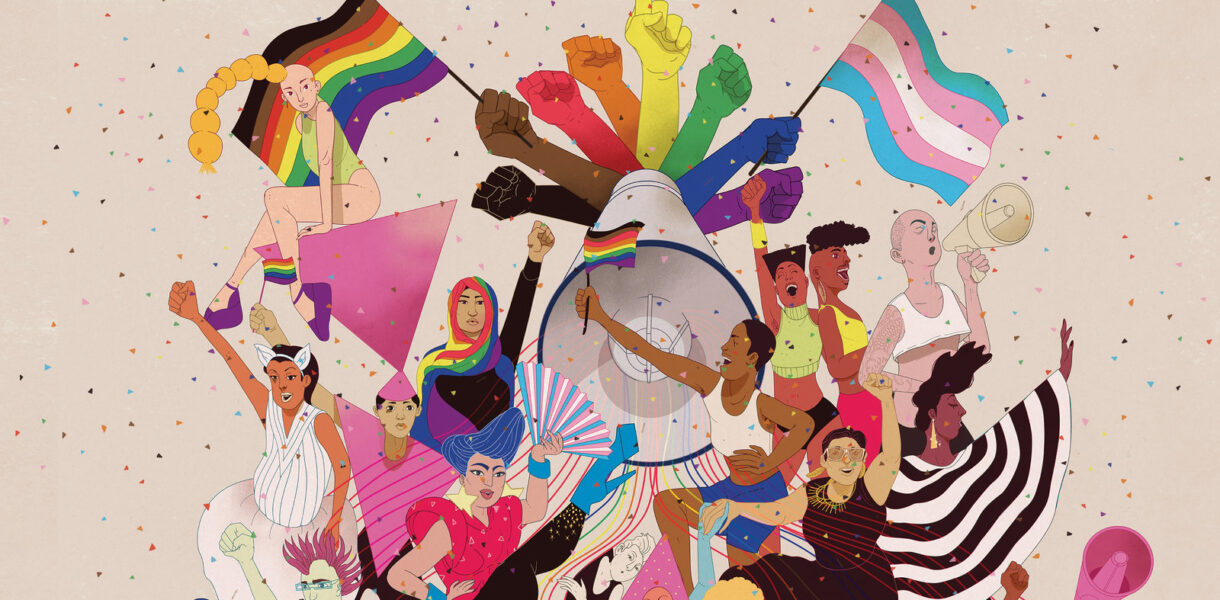
IMPORTANCE OF A DIVERSE AND INCLUSIVE BOARD
In a world where members of the LGBTQ++ community are struggling to get access to public toilets, talking about them being represented at a corporate board might sound too distant, however it is no less relevant than any other issue of underrepresentation being faced by them. Also, with third wave of feminism beautifully embracing intersectionality, the discussion around diversity and inclusivity in any sector cannot be restricted to gender binarism. Thus, to give representation to these voices which have been unheard since so long would not be sufficient, it is important to actually listen to what they are they are saying by involving them in decision and policy making process.
The objective of business or trade is no more limited to making monetary profits and boosting economies, the recent trend is involving even the corporate sector in the drive for social change and making them contribute their bit in developing an egalitarian society. The implementation of this theory can be profoundly witnessed in the concept of “Corporate Social Responsibility” which needs no elaboration. Another reflection of this theory can be found in the form of ‘Good Governance Practices’ which the corporations undertake in order to make efficient use of the Human resources by developing an environment of confidence.
Making the Board gender diverse and inclusive is also counted among such practices as it recognize and celebrate the individuality of human kind and also indirectly affects decision making in a positive manner. However, it is unfortunate that most of the discussion around gender diversity in the Board hovers around ‘women’ and fails to recognise the fluidity of the term ‘gender’ by forgetting or sometimes ignoring the LGBTQ++ community. One cannot deny the fact that talks of the boardroom and the decisions taken therein are going to affect all of us in one way or the other which makes the representation of marginalised sections of the society even more important than ever.
Following are some of the advantages of having a gender diverse board:
- Financial Impact:-
There have been a number of studies conducted to find out the relationship, if any, between a gender diverse board and the economic performance of the company. Though no direct relationship could be established till now, but according to a research in France at the Université Savoie Mont Blanc which looked at the performance of French CAC40-listed companies between 2008 and 2012 concluded that “companies whose boards are more diverse in terms of gender achieve higher performance indicators, all else being equal”.[1]
- Impact on policies :
A gender diverse board also helps to limit groupthink approach to policy making, thus celebrating the differences and individual identities. It largely helps in gaining the confidence of the consumers and maintenance of integrity in board members.
- Impact on work environment :
Representation of LGBTQ++ community in the board and their participation in the decision making will also help in creating a healthy work environment at the lower levels of the organization which will include coming out of closeted employees.
- Impact on Human Resource :
Their presence in the Boardroom might serve as an incentive to other employees belonging to the LGBTQ++ community. They will want to remain associated with the company and work to their full potential as they will witness the opportunity for themselves being promoted to the boardroom someday.
All the points discussed hereinbefore are undoubtedly going to have a huge impact on the performance of the organisation on the economic as well as the social front, thus expanding the horizons of board to make it gender inclusive.
REPRESENTATION OF LGBTQ COMMUNITY IN THE CORPORATE SECTOR- A GLOBAL PICTURE
The exact number of LGBTQ++ employees in various corporations is difficult to assess as due to stigma and other prejudices against them as well as unsafe environment, most of them remain closeted throughout. However, with Apple CEO Tim Cook coming out publically, the picture might change in the upcoming years. Recently, when Land’ O Lakes named Beth Ford as its CEO, the world also got its first openly LGBTTQ++ women CEO of a Fortune 500 company. Adding Jim Fitterling, CEO, Dow Chemical Company, to this list, the total number of openly LGBTQ++ CEOs of Fortune 500 companies stands at 3.[2] Keeping pace with these developments, another brighter picture was recently painted by Nasdaq, when it proposed to Securities and Exchange Commission (SEC) of America to make it a mandatory practice for Nasdaq listed companies to disclose the composition of their Board publically and also provide reasons for not complying with board heterogeneity threshold provided by Nasdaq. In its proposal the Nasdaq has asked the Companies to mandatorily include at least one woman member and one belonging to underrepresented minorities or LGBTQ++ community. The companies may be delisted if they failed to comply or give satisfactory reasons for non-compliance.[3]
In U.K., the Financial Regulatory Council (FRC), which is responsible for the enforcement of Corporate Governance Code recently commissioned a research in which it highlighted the discrimination that is faced by employees belonging to LGBTQ++ community at their workplace. The report listed down a number of recommendations to make the workplace gender inclusive and board diverse.[4]
Apart from these initiatives, corporate giants such as Walmart, McKesson, Amazon, Verizon Communications (total 214 out of Fortune 500 Companies) are leading an example by making and implementing non-discriminatory policies. According to the Corporate Equality Index released by the Human Rights Campaign Foundation, “91% of Fortune 500 companies have included gender identity in their protection policies; 65% of them include transgender in their health-care package and over 570 major business corporations have adopted gender transition guidelines for employees.”[5]
The above mentioned figures and practices might be able to paint a rosy picture in the minds of the reader, however one must not commit the mistake of ignoring the fact that the colours contributing to this rosy picture are coming only from some selected areas of the world (U.S., U.K.). These areas are not the world and Fortune 500 companies are not corporate sector but only a small portion of these respectively. The bread beneath this cream frosting is still stinking of extremities the members of this community have to face including torture, death sentence and other forms of sanctions merely because of their identity. Overall, the social power structure still place them at the bottom of the hierarchy which clearly has an impact on the culture at the workplace as highlighted by a number of studies conducted.
REPRESENATION OF LGBTQ COMMUNITY IN THE CORPORATE SECTOR- THE INDIAN PICTURE
In India the society was comparatively more open as our mythology is full of heroes belonging to the LGBTQ++ community such as Shikhandi in Mahabharat , ‘Ardhanarishwar’ the fusion of Shiv and Shakti and ‘Mohini’ the feminine self of Lord Vishnu. The mesmerizing beauty of Khajuraho temple lies in its depiction of human sexuality in its raw form. Also, the resources concerning Mughal history talk about eunuchs enjoying a respectable position and being employed as caretakers of ‘Haram’ or the resident palace of royal women and lest we forget Malik Kafoor, the unsung hero who led and won a number of campaigns on behalf of Alauddin Khilji.
However, it was the British who brought in with them the homophobia and criminalised gay sex by incorporating section 377 in the Penal Code. India has very recently freed itself from the clamps of this Draconian law when the Supreme Court delivered the historic judgement[6] on Sept. 6, 2018 declaring the section 377 as unconstitutional to the extent that it criminalised consensual sex between two adults. Before this, it was the Delhi High Court judgement in NLSA case[7] which ushered in a new era of equality for trans- genders.
It was not until recently that Indian companies started framing as well as implementing gender inclusive policies. However, this delay and the normalised discrimination at workplace cannot be imposed upon section 377 as it criminalised merely the sexual intercourse between two homosexual individuals and not their very identity and existence. The biggest factor behind this delay can be attributed to the inherently patriarchal mind set prevalent in the society, as company policies are largely driven by consumer and market behaviour.
Though the Supreme Court judgement does not apply to private players but only to State and its instrumentalities, the least it has achieved is to bring up the topic of LGBTQ++ in public sphere.
Recently, Tech Mahindra removed one of its employees after he was accused of discriminatory behaviour towards another former employee for being homosexual. The latter had made the allegations via a tweet which was followed by an investigation into the matter and finally the expulsion. This was just a secluded incident in which the victim was brave enough to make the complaint, there is no record of those who are suffering in silence.
However, having an optimistic approach allows one to appreciate the following steps taken by various companies to make the work environment inclusive:
- To hire and provide safe environment to LGBTQ people, Mahindra Logistics has launched a policy concerning several guidelines.
- ‘Project Rainbow’ has been launched by Godrej to provide a platform to LGBTQ people, who are looking for an internship or employment in the country.
- Companies like Godrej and Mahindra have expanded their health care and other beneficial policies to cover same-sex partners along with spouse and other family members.
- Godrej and Publicis sapient have expanded their medical insurance benefits to cover the costs of gender reaffirmation surgery undergone by any trans-gender employee.[8]
Other than these policy changes, many of these companies have started gender sensitization programs in order to sensitize the employees towards their fellow LGBTQ employees.
ROLE OF STATE IN MAKING A DIVERSE AND INCLUSIVE BOARD- CASE STUDY OF CALIFORNIA
On September 1, 2020, ‘Assembly Bill 979’[9] has been signed by Governor Gavin Newsom, as a consequence of which, it is now mandatory for corporations which have their headquarters in California to have at least one director belonging to an underrepresented community on the Board of Directors.[10]
The new law inserts a new section 301.4 in the “Corporations Code”. According to the provisions of this section,
General Provision
- By the end of the year 2021, domestic or foreign Corporation headquartered in California shall have at least one director from an underrepresented community.
- This minimum threshold is to be increased in proportion to the total number of Directors, as provided in the section, by the end of the year 2022.
- The Secretary of state has to include in its annual report the statistics pertaining to compliance of this provision.
Implementation and Penalty
The section provides for imposition of fine ranging from one hundred thousand dollars to three hundred thousand dollars, which will be used to offset the cost incurred to implement the said provision.
Meaning of underrepresented community
“Underrepresented community shall include within it any individual who self-identifies as Black, African American, Hispanic, Latino, Asian, Pacific Islander, Native American, Native Hawaiian, or Alaska Native, or who self-identifies as gay, lesbian, bisexual, or transgender.”[11]
Constitutional validity
As is the situation with most of the laws providing for quotas, the situation is no different for this one also. The constitutional validity of the law has already been challenged on the grounds for violation of equality. It is being asserted in the suits that one cannot be denied a position merely because of the gender he/she is born with.
Other legislations protecting LGBTQ rights in California
There are two other existing laws which give a general protection to LGBTQ employees against discrimination, namely;
- California Fair Employment and Housing Act (FEHA)[12] and;
- Title VII of the Federal Civil Rights Act (Title VII)[13]
A cumulative reading of these acts bring out the following protection which are available:
- Discrimination in any form (demotion, fire, wage reduction etc.) against an employee due to his/her gender expression is illegal.
- An individual cannot be required to disclose his/her gender identity or sexual orientation, nor while making a job application, neither during the interview.
- Health care benefits provided by employers cannot exclude gender-affirmation treatment as well.
- Health insurance cover provided by the employer must extend to ‘same-sex’ spouse in a similar manner as to a spouse in a heterosexual couple.[14]
Thus, it can be concluded that California is undoubtedly leading the march by being the flag bearer. The abovementioned State legislatures provide an ample amount of protection to the community, however strict implementation is a major hurdle. One of the major factors behind this implementation challenge is ambiguous words used in the provisions which are open to interpretation or have more than one possible meanings.
Nevertheless, the other countries may still learn a lesson or two and take initiatives at the legislative level to protect the rights of such underrepresented minorities.
LEADING THE WAY IN INDIA- A BRIEF CASE STUDY OF GODREJ GROUP
Parmesh Sahani, Vice President and head of Godrej India group came out as gay in 2004 by telling his father, “The BBC says I am gay, so it must be true because it’s the BBC”. Today, Godrej group offers one of the most LGBTQ friendly workspace in the country andone of the major factor behind this is the efforts of its Vice chairman who himself is a champion of LGBTQ rights and is leading the fight since a long time against all forms of discrimination against the community. Parmesh Sahani, author of books ‘Gay Bombay’ and ‘Queeristan’ came up with the idea of Godrej India Culture Lab in 2011 and currently heads it.[15]
It is an event based platform primary for the exchange and free flows of innovative ideas without any filter or censor. Generally, contemporary issues are the theme of the events which are organised and every individual has freedom to express itself. This platform is unique because of its dynamic approach which is miles apart from the Boardroom atmosphere.
Theme of the annual events organised in 2016 was revolving around Gender Sensitization and it witnessed some of the stellar cultural performances relating to the issue. Dance performance by the troupe “Dancing Queens” deserves a mention as the dancers were all trans-gendered and the performance had a huge impact on the viewers. Apart from these, LGBTQ activists such as Kiruba Manuswamy and many others were invited as speakers who reflected upon various issues faced by the members of the community. A white paper was also released focussing on the approach to be adopted by the group to provide a safe work environment for each of its employee regardless of their gender identities.[16]
It will not be right to assume that the ideas which flow in the culture lab remain ideas only, their metamorphosis into policy and implementation can easily be seen in the various provisions which the group has enacted in order to ensure equal treatment for everyone at the work place and a healthy work environment. These provisions range from project Rainbow to coverage of same sex spouse in the employer health insurance etc., most of which are already discussed above.
CHALLENGES AND FURTHER STRATEGIES
Almost all the challenges faced by the individuals of queer community spur directly or indirectly from stigmatized mind- set prevalent in the society. The group as a whole, faces discrimination as extreme as being treated as untouchables.
They suffer oppression in various aspects of life such as social, economic as well as physical. The form ranges from taunts to bullying and end at physical torture (sometimes by State itself). What might be a simple joke for the one who is cracking it is sometimes bullying for a LGBTQ++ person and effect their mental health in an adverse manner.
All these combine together and prevent them from coming out of the closet and express their true selves. It gradually affects their work performance which might reflect in the efficiency of the Corporation they are working for.
Some of the strategies which can be adopted by the corporations to overcome these challenges and creating a safe work environment for everyone could be:
- Inclusion
From cubicle to Boardroom, inclusion is the key. Having a voice from LGBTQ++ community in the Boardroom will directly affect the policies and other decision being made there and will ensure that they are not exclusionary towards any group.
Policies can be made inclusive of all by extending all the benefits such as health and other insurance benefits to everyone. Child care leave policy should include same sex couple as well.
- Effective Grievance Redressal Committee:
There should be a separate committee, preferably totally independent to address the grievances relating to gender discrimination or any kind of harassment faced by an individual because of having a particular gender identity or sexual orientation. The committee should include persons belonging to LGBTQ++ community in a reasonable proportion and should work in a time bound and fair manner. The corporation should chalk out and draft a comprehensive mechanism for grievance redressal after including the ideas and opinions of members representing LGBTQ++ community.
- Use of correct pronouns:
All efforts should be made to use the pronouns preferred by each person for itself. Nobody should be forced to disclose the gender identity while filling out any application form or during an interview. Also, instead of writing ‘others’, proper terminology available for other genders should be used.
- Gender sensitization:
The corporation should take effective measures to organize gender sensitization drives. This may include cultural events, courses, seminars, book discussions etc. Live interactions with LGBTQ++ activists should be organized on a periodic basis.
- Infrastructure:
Gender neutral washrooms should be necessarily constructed and every person should be allowed to use the washroom according to its preference.
CONCLUSION
The assumption that LGBTQ is merely a form or gender or sexual orientation itself is flawed. It is something beyond that, it is the identity one is born with, an inseparable part of life which effects everything from the social life to personal life.
Despite bodily autonomy being a fundamental right in most of the countries including India, things have not been in their interest. Homophobic and transphobic jokes have been so normalized in our language and behaviour that hardly one realizes that it is offensive to an entire community. Taking the example of India, the oppression ranges from jokes and taunts to criminalization of their sexual activity until very recently. Ours is a patriarchal society in which the flow of oppression is towards non cis heterosexual males i.e. everyone who is not a cis gendered heterosexual male is at the lower strata of the society. Women, trans- people, LGBTQ++ individuals, all face oppression in one form or the other.
The corporate culture as well has not been able to transgress the effects of this inherent mind set. Since most of the policies and decisions of any corporation depends upon the behaviour of the market and the consumers, society thus play a major and impactful role.
However, the last decade saw an increase in the activism for women and LGBTQ rights. Both these movements grew and marched somewhat parallel mainly because of their common fight against patriarchal society. Third wave of feminism is intersectional feminism which takes with itself rights of other minorities as well which are at the lower stratus of the society. The Indian Companies Act, 2013 as well as the CII desirable code for corporate governance makes provision for a proportion of Women directors in the Board, there is no such provision for LGBTQ++ persons as of now. The picture is more or less similar for other countries of the world as well.
Despite contributing a major share in the world economy, also known as ‘Pink economy’, the pace of their inclusion in boardroom is very slow. According to a World Bank report, India is losing a good amount of GDP due to the corporate workspace not being inclusive of LGBTQ++ community.
Corporate world needs to understand the value of having an inclusive and diverse Board by giving due representation to the underrepresented minority communities. Meanwhile, even the states being the parens patriae take initiatives to safeguard the rights of the LGBTQ++ community in corporate sector as well by offering incentives and rewards for the best performing Corporation in terms of LGBTQ++ friendly policies and their effective implementation.
About the Author
-
Patricia Lenkov, LGBT in the Boardroom, https://ethicalboardroom.com/lgbt-in-the-boardroom/ (Nov 28, 2020, 6:35 pm). ↑
-
Hannah Fairbanks, How Openly LGBTQ+ Fortune 500 CEOs are changing the Corporate Game, https://theriveter.co/voice/openly-lgbtq-fortune-500-ceos-who-will-be-next/ (Dec 19, 2020, 7:22 p.m.). ↑
-
Reuters Straff, Nasdaq proposes board diversity requirement for listed companies, https://in.reuters.com/article/us-nasdaq-sec-diversity/nasdaq-proposes-board-diversity-requirement-for-listed-companies-idUSKBN28B58Q (Dec 19, 2020, 9:00 p.m.). ↑
-
Catriona Hay et al, Building more open Business, https://www.frc.org.uk/getattachment/19f3b216-bd45-4d46-af2f-f191f5bf4a07/The-Good-Side-x-Financial-Reporting-Council-Buidling-more-open-business-2011.pdf (Dec 19, 2020, 11:10 p.m.). ↑
-
Human Rights Campaign Foundation, Corporate Equality Index 2020, https://hrc-prod-requests.s3-us-west-2.amazonaws.com/files/assets/resources/CEI-2020.pdf?mtime=20200713132437&focal=none (Dec 20, 2020, 11:54 a.m.). ↑
-
Navtej Singh Johar v. Union of India, (2018) 1 SCC 791. ↑
-
National Legal Services Authority v. Union of India, (2014) 5 SCC 438. ↑
-
Shefali Anand, Employers in India expand Inclusion to cover LGBTQ employees, https://www.shrm.org/resourcesandtools/hr-topics/global-hr/pages/india-inclusion-lgbtq-employees.aspx (Dec 21, 2020, 7:55 p.m.). ↑
-
AB 979 Corporations: Corporations: Board of directors: Underrepresented Communities. ↑
-
Kim Bozoroque, Gavin Newsom signs law requiring California companies to name minority or LGBTQ leaders, https://www.sacbee.com/news/politics-government/capitol-alert/article246016865.html (Dec 27, 2020, 11:34 am). ↑
-
CORP, §301.4, (Thomas Reuters 2020). ↑
-
2 FEHA (West 2019). ↑
-
Civil Rights Act of 1964, 7, U.S.C. ↑
-
ACLU California, https://www.aclusocal.org/en/know-your-rights/california-lgbtq-employment-rights (Dec 27, 2020, 6:33 pm). ↑
-
Aashika Jain, The Flag- bearer of equality at Workplace, https://www.entrepreneur.com/article/323194, (Dec 27, 2020, 8:04 p.m.). ↑
-
Godrej India Culture Lab, https://indiaculturelab.org/, (Dec 27, 2020, 7:20 pm). ↑





I was able to find good information from your blog posts.
When someone writes an article he/she maintains the plan of a user in his/her
mind that how a user can be aware of it. Thus that’s why this piece of
writing is great. Thanks!
Stunning story there. What occurred after? Thanks!